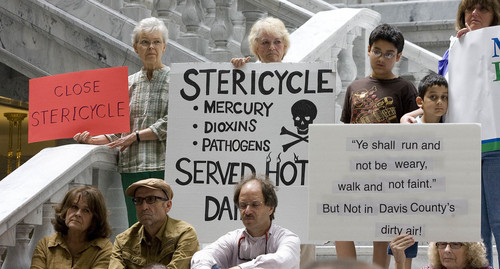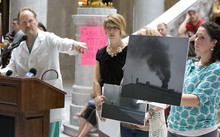This is an archived article that was published on sltrib.com in 2013, and information in the article may be outdated. It is provided only for personal research purposes and may not be reprinted.
Utah hospitals send tons of medical waste to Stericycle each year for incineration.
But as community activists fight to shut down the North Salt Lake incinerator for alleged emissions violations, at least one hospital group, University of Utah Health Sciences, is rethinking the practice.
"Originally, nationwide they were a leader in the industry," said U. hospital spokeswoman Kathy Wilets. "However, in light of concerns raised from the community about air-quality issues related to the company, we are in the process of evaluating our contract."
American hospitals produce 33.8 pounds of waste per day per hospital bed, according to Practice Greenhealth, a support network that helps health centers reduce their carbon footprints.
There are 5,735 staffed hospital beds in Utah, according to the Utah Hospital Association — translating to 97 tons of waste per day.
Most of it is conventional garbage — paper, cardboard, food waste — that is either recycled or dumped in landfills. But hospitals also churn out a complicated mix of infectious medical waste that has to be separated and treated, including blood-soaked bandages, used syringes, expired prescription drugs and hazardous chemicals.
According to the U.S. Environmental Protection Agency, 90 percent of this potentially infectious material is sent to incinerators, which emit greenhouse gasses, dioxins and other toxic substances.
But hospitals, recognizing the links between environmental harms and disease, are eyeing newer, greener waste-management technologies.
One option being weighed by the U.: on-site machines to sterilize waste and render it nonhazardous for disposal in lined landfills.
"[Stericycle] is not the only game in town. There are lots of different systems," said Michele Johnson, director of Environmental Health and Safety at the U.
Each strategy, though, comes with benefits and risks, including cost, she said. "Cost always comes into play. As a state institution, we have to be sensible and wise with taxpayer dollars."
But environmental groups contend incineration isn't the cheapest alternative. It's outdated, they say, and should be abandoned by hospitals heeding the pledge to do no harm.
"There are no laws in the U.S. that require incineration of medical waste. In fact, a few countries have banned it," said Brian Moench, president of Utah Physicians for a Healthy Environment. "It's ironic that through the front door hospitals promote health and lifesaving procedures but through the back door they're actually spreading disease and poor health through the toxicity of the waste they deliver."
Utah hospitals treat and bury most of their waste, but all of them set fire to some of it. And all but one major health chain — MountainStar — contracts with Stericycle.
MountainStar, owner of St. Mark's Hospital, has "not done business with Stericycle," said company spokeswoman Audrey Glasby. Its waste is treated and sent to a Utah landfill run by Waste Management, with a small portion burned at a facility in Maryland.
Roughly 15 percent of the disposal needs of IASIS Healthcare's four Utah hospitals are met by the Stericycle plant, and the rest of the waste is sent to other facilities, said Laura Walsh, director of marketing for the Western region.
Intermountain Healthcare, Utah's largest hospital chain, is always exploring new technologies but has no plans to end its relationship with Stericycle, said its spokesman Daron Cowley, noting Intermountain accounts for 1.6 percent of what Stericycle burns.
Moench said residents of the Foxboro neighborhood surrounding Stericycle first approached Intermountain four years ago with their emissions concerns.
State regulators allege smoke coming from Stericycle's stack has exceeded limits for dioxin, furan and nitrous oxides.
The facility also failed to properly report these events and rigged a stack test, regulators say.
Stericycle has denied and taken legal steps to fight those claims.
But community and public health activists want Utah Gov. Gary Herbert to use his executive authority to shut down the plant, and they're lobbying hospitals to stop contributing to the problem.
"They will start to see protests in front of their hospitals, which they probably don't want," said Moench.
Cowley said Intermountain has taken steps to reduce pollution, including transitioning many of its delivery vehicles to natural gas. "Everyone is aware there are air-quality issues along Wasatch Front," he said.
But incineration is the only option for some waste, he said, citing a Utah law requiring that body parts "be disposed by incineration or interment in a location appropriate for human remains." Intermountain has interpreted "appropriate location" to mean a cemetery.
Scott Anderson, director of the Utah Division of Solid and Hazardous Waste, defines it as including landfills. "All of the waste that Stericycle handles could be buried," he said.
The benefit of burning is that it destroys the waste, Anderson said. "Whereas if it's buried, someone still has it and they have to take care of it."
And should something happen to a landfill, such as it being sold or leachate entering an aquifer, surface water or drinking water, hospitals that generated the waste can be held liable, he said.
The U. uses Stericycle only for "residual chemotherapy" agents, about 40,000 pounds annually of such items as empty IV bags, tubing and contaminated gowns and gloves, said Greg Walters, the U.'s hazardous waste specialist. The relationship dates back to at least 1997, the university says.
Partial chemotherapy doses and experimental medications are shipped to Clean Harbors' Aragonite facility in Tooele for incineration at hotter temperatures than Stericycle allows, Walters said.
The Aragonite facility is permitted differently than Stericycle, as a hazardous waste, not a solid waste, incinerator.
"Their kiln burns hotter and they have slew of scrubbers on their stacks," Walters said. They also charge three times more than Stericyle per 50-gallon drum of waste, he said.
Burying chemo waste is an option that would be less expensive than incineration, but it increases the risk of human exposure, he said. "People who [sterilize] it could be exposed and there may be some effluent [toxic chemicals] that go down the drain."
Weighing the trade-offs, environmental groups argue the balance falls in favor of landfills, especially in highly populated areas that struggle with air pollution.
Not all toxins are mitigated by incineration, including heavy metals, polycyclic aromatic hydrocarbons and dioxins, which are created through combustion, said Moench.
"The chemo-incineration argument completely ignores the fact that we are creating new toxic compounds that are horribly carcinogenic and redistributing them across the community in a way that they wouldn't have been otherwise," said Moench. "There's absolutely nothing compelling to argue it must be incinerated. ... I think it's mainly that we're doing this out of habit."
Twitter: @kirstendstewart









